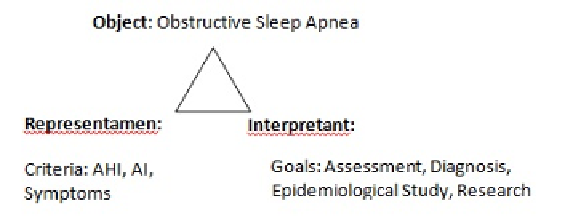Information Technology Reference
In-Depth Information
modifiers,” which represent the notion of “interpretant” or utilization. This notion
focuses on the role of interpretation (interpreter) in the creation of meaning. We
called them modifiers since in a way, they “modify” the meaning. We identified four
groups of modifiers (this is not an exhaustive list of possible modifiers): goals (e.g.,
diagnosis, assessment, treatment evaluation), agents (e.g., patients, health profes-
sionals, medical sensors, computer systems), perspectives (e.g., health care costs,
accessibility, ethics), and views (e.g., variations in the diagnostic criteria used by
different experts or clinics). The names of the modifiers are used here in an arbi-
trary fashion, and they are introduced here to indicate various sources of modifica-
tions. For example, the important modifiers are health-care costs and accessibility of
specialists.
The modeling of the concept of
OSA
in the context of various goals involves three
aspects: conceptualization (what to measure), operationalization (how to measure),
and utilization (how the measure is applied). We mapped these aspects using the
semiotic triangle, shown in Figure 13.4.
Fig. 13.4
Peircean semiotic triangle for contextual modeling of
OSA
The multiplicity of diagnostic criteria and ongoing modifications clearly indicate
the need for a flexible computational representation, which must model the various
criteria and approaches to the diagnosis, assessment, and treatment of
OSA
(and
other sleep disorders).
13.5
Conclusions and Future Work
In this paper, we have discussed the typology of medical concepts introduced by
Dr. Kazem Sadegh-Zadeh in his
Handbook of Analytic Philosophy of Medicine
.
Specifically, we have concentrated on three issues: non-classical concepts, qual-
itative concepts, and operational definition of concepts. We have used an exam-
ple of obstructive sleep apnea to demonstrate that (1) medical concepts are created
and used for specific purposes and must be interpreted in the context of these pur-
poses; (2) medical concepts rarely have clearly defined boundaries; most concepts
are fuzzy; (3) clinical concepts are used in specific contexts and are subject to var-
ious interpretations; and (4) clinical concepts evolve over time. To address these

